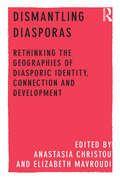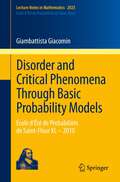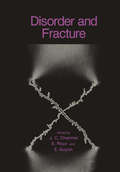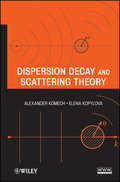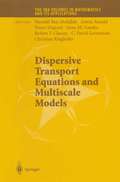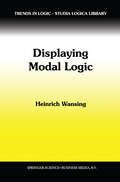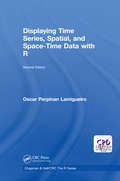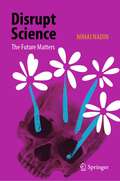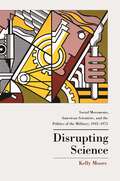- Table View
- List View
Diskrete Strukturen: Band 1: Kombinatorik, Graphentheorie, Algebra (Springer-Lehrbuch)
by Angelika StegerDieses Lehrbuch umfaßt Themen, die mittlerweile an vielen Universitäten unter dem Titel "Diskrete Strukturen" fester Bestandteil des Informatik-Grundstudiums sind. Die Autorin legt in ihrer Darstellung neben der mathematischen Exaktheit besonderen Wert darauf, das intuitive Verständnis zu fördern. Ihr didaktischer Ansatz hilft Studenten dabei, den Stoff leichter zu verstehen und einzuordnen. Zahlreiche Beispiele und Aufgaben, vorwiegend aus dem Bereich der Informatik, unterstützen ihr Anliegen. Die Themen: Kombinatorik, Graphentheorie, algorithmische Grundprinzipien, Rekursionsgleichungen, Algebra.
Diskrete Strukturen 1: Kombinatorik, Graphentheorie, Algebra (Springer-Lehrbuch)
by Angelika StegerDieses Lehrbuch umfaßt einen Kanon von Themen, der an vielen Universitäten unter dem Titel "Diskrete Strukturen" fester Bestandteil des Informatik-Grundstudiums geworden ist. Bei der Darstellung wird neben der mathematischen Exaktheit besonderer Wert darauf gelegt, auch das intuitive Verständnis zu fördern, um so das Verstehen und Einordnen des Stoffs zu erleichtern. Unterstützt wird dies durch zahlreiche Beispiele und Aufgaben, vorwiegend aus dem Bereich der Informatik. Das Lehrbuch basiert auf Vorlesungen, die seit mehreren Jahren an der Technischen Universität München gehalten werden.Themen: Kombinatorik, Graphentheorie, Algorithmische Grundprinzipien, Rekursionsgleichungen, Algebra.
Diskrete Strukturen 2: Wahrscheinlichkeitstheorie und Statistik (Springer-Lehrbuch)
by Thomas Schickinger Angelika StegerDieses zweibändige Lehrbuch umfaßt einen Kanon von Themen, der an vielen Universitäten unter dem Titel "Diskrete Strukturen" fester Bestandteil des Informatik-Grundstudiums geworden ist. Bei der Darstellung wird neben der mathematischen Exaktheit besonderer Wert darauf gelegt, auch das intuitive Verständnis zu fördern, um so das Verstehen und Einordnen des Stoffs zu erleichtern. Unterstützt wird dies durch zahlreiche Beispiele und Aufgaben, vorwiegend aus dem Bereich der Informatik. Das Lehrbuch basiert auf Vorlesungen, die seit mehreren Jahren an der Technischen Universität München gehalten werden.Themen des zweiten Bandes: Endliche und unendliche Wahrscheinlichkeitsräume, Markov-Ketten, Warteschlangen, Induktive Statistik.
Diskrete und algebraische Strukturen - kurz gefasst
by Ulrich Knauer Kolja KnauerDieses Lehr- und Studienbuch präsentiert die Themen, die üblicherweise in der Standardvorlesung über diskrete Strukturen behandelt werden. Die Darstellung wendet sich an Studierende der Informatik und der Mathematik (Lehramt und Bachelor/Master) und ist als Vorlesungsbegleitung, zum Selbststudium und zur Prüfungsvorbereitung konzipiert.Zahlreiche Aufgaben erleichtern die Vertiefung des Lernstoffs. Durch die kompakte Darlegung aller wichtigen diskreten und algebraischen Strukturen und das umfangreiche Stichwortverzeichnis eignet sich das Buch zudem als Nachschlagewerk für Mathematiker, Informatiker und Naturwissenschaftler.Inhalte: Von der Aussagen- und Prädikatenlogik über Mengen und Kombinatorik, Zahlen, Relationen und Abbildungen, Graphen bis hin zu dem reichhaltigen Spektrum algebraischer Strukturen und einem kurzen Einblick in die Kategorientheorie.Die 2. Auflage ist vollständig durchgesehen und enthält neben zusätzlichen Kapiteln zu Ringen und Moduln sowie zu Matroiden nun erstmals auch typische Klausuraufgaben.
Dismantling Diasporas: Rethinking the Geographies of Diasporic Identity, Connection and Development
by Anastasia Christou Elizabeth MavroudiRe-energising debates on the conceptualisation of diasporas in migration scholarship and in geography, this work stresses the important role that geographers can play in interrupting assumptions about the spaces and processes of diaspora. The intricate, material and complex ways in which those in diaspora contest, construct and perform identity, politics, development and place is explored throughout this book. The authors ’dismantle’ diasporas in order to re-theorise the concept through empirically grounded, cutting-edge global research. This innovative volume will appeal to an international and interdisciplinary audience in ethnic, migration and diaspora studies as it tackles comparative, multi-sited and multi-method research through compelling case studies in a variety of contexts spanning the Global North and South. The research in this book is guided by four interconnected themes: the ways in which diasporas are constructed and performed through identity, the body, everyday practice and place; how those in diaspora become politicised and how this leads to unities and disunities in relation to 'here' and 'there'; the ways in which diasporas seek to connect and re-connect with their 'homelands' and the consequences of this in terms of identity formation, employment and theorising who 'counts' as a diaspora; and how those in diaspora engage with homeland development and the challenges this creates.
Dismantling Diasporas: Rethinking the Geographies of Diasporic Identity, Connection and Development
by Anastasia Christou Elizabeth MavroudiRe-energising debates on the conceptualisation of diasporas in migration scholarship and in geography, this work stresses the important role that geographers can play in interrupting assumptions about the spaces and processes of diaspora. The intricate, material and complex ways in which those in diaspora contest, construct and perform identity, politics, development and place is explored throughout this book. The authors ’dismantle’ diasporas in order to re-theorise the concept through empirically grounded, cutting-edge global research. This innovative volume will appeal to an international and interdisciplinary audience in ethnic, migration and diaspora studies as it tackles comparative, multi-sited and multi-method research through compelling case studies in a variety of contexts spanning the Global North and South. The research in this book is guided by four interconnected themes: the ways in which diasporas are constructed and performed through identity, the body, everyday practice and place; how those in diaspora become politicised and how this leads to unities and disunities in relation to 'here' and 'there'; the ways in which diasporas seek to connect and re-connect with their 'homelands' and the consequences of this in terms of identity formation, employment and theorising who 'counts' as a diaspora; and how those in diaspora engage with homeland development and the challenges this creates.
Disorder and Critical Phenomena Through Basic Probability Models: École d’Été de Probabilités de Saint-Flour XL – 2010 (Lecture Notes in Mathematics #2025)
by Giambattista GiacominUnderstanding the effect of disorder on critical phenomena is a central issue in statistical mechanics. In probabilistic terms: what happens if we perturb a system exhibiting a phase transition by introducing a random environment? The physics community has approached this very broad question by aiming at general criteria that tell whether or not the addition of disorder changes the critical properties of a model: some of the predictions are truly striking and mathematically challenging. We approach this domain of ideas by focusing on a specific class of models, the "pinning models," for which a series of recent mathematical works has essentially put all the main predictions of the physics community on firm footing; in some cases, mathematicians have even gone beyond, settling a number of controversial issues. But the purpose of these notes, beyond treating the pinning models in full detail, is also to convey the gist, or at least the flavor, of the "overall picture," which is, in many respects, unfamiliar territory for mathematicians.
Disorder and Fracture (Nato Science Series B: #204)
by J. C. Charmet E. Guyon Stéphane RouxFracture, and particularly brittle fracture, is a good example of an instability. For a homogeneous solid, subjected to a uniform stress field, a crack may appear anywhere in the structure once the threshold stress is reached. However, once a crack has been nucleated in some place, further damage in the solid will in most cases propagate from the initial crack, and not somewhere else in the solid. In this sense fracture is an unstable process. This property makes the process extremely sensitive to any heterogeneity present in the medium, which selects the location of the first crack nucleated. In particular, fracture appears to be very sensitive to disorder, which can favor or impede local cracks. Therefore, in most realistic cases, a good description of fracture mechanics should include the effect of disorder. Recently this need has motivated work in this direction starting from the usual description of fracture mechanics. Parallel with this first trend, statistical physics underwent a very important development in the description of disordered systems. In particular, let us mention the emergence of some "new" concepts (such as fractals, scaling laws, finite size effects, and so on) in this field. However, many models considered were rather simple and well adapted to theoretical or numerical introduction into a complex body of problems. An example of this can be found in percolation theory. This area is now rather well understood and accurately described.
Disorder and Mixing: Convection, Diffusion and Reaction in Random Materials and Processes (NATO Science Series E: #152)
by E. Guyon J. P. Nadal Yves PomeauCARGESE INSTITUfE ON DISORDER AND MIXING Convection, diffusion and reaction are the three basic mechanisms in physico-chemical hydrodynamics and chemical engineering. Both convective and diffusive processes are strongly influenced by the effect of disorder of granular matter in porous media, suspensions, fluidized beds or/and by the randomness caused in turbulent flow field. This book has been initiated by a NATO summer institute held in Cargese (Corsica, FRANCE) from June 15 th to 27 th 1987 . Its aim was to associate statistical physicists, fluid mechanicians and specialists of chemical engineering on the problems of the relation between disorder and mixing and, in this respect, this is a " premiere ". This book is made of chapters based on lectures given in the meeting. However we have paid a considerable attention to harmonize the contents and styles of chapters made by scientists trained in different communities and using different languages and techniques to describe similar problems. The Prelude by the editors of the book introduces the different points and is a biased view of some of the important and most active aspects of the subjects developed. We wish to thank all contributors and students of the institute who gave the style of the present interdisciplinary approach. We also greatly thank Elisabeth Charlaix who has shared with us the scientific and practical organisation of the institute, and Marie-France Hanseler for her technical support.
Disorder and Nonlinearity: Proceedings of the Workshop J.R. Oppenheimer Study Center Los Alamos, New Mexico, 4–6 May, 1988 (Springer Proceedings in Physics #39)
by Alan R. Bishop David K. Campbell Stephanos Pnevmatikosill the past three decades there has been enonnous progress in identifying the es sential role that "nonlinearity" plays in physical systems. Classical nonlinear wave equations can support localized, stable "soliton" solutions, and nonlinearities in quantum systems can lead to self-trapped excitations, such as polarons. Since these nonlinear excitations often dominate the transport and response properties of the systems in which they exist, accurate modeling of their effects is essential to interpreting a wide range of physical phenomena. Further, the dramatic de velopments in "deterministic chaos", including the recognition that even simple nonlinear dynamical systems can produce seemingly random temporal evolution, have similarly demonstrated that an understanding of chaotic dynamics is vital to an accurate interpretation of the behavior of many physical systems. As a conse quence of these two developments, the study of nonlinear phenomena has emerged as a subject in its own right. During these same three decades, similar progress has occurred in understand ing the effects of "disorder". Stimulated by Anderson's pioneering work on "dis ordered" quantum solid state materials, this effort has also grown into a field that now includes a variety of classical and quantum systems and treats "disorder" arising from many sources, including impurities, random spatial structures, and stochastic applied fields. Significantly, these two developments have occurred rather independently, with relatively little overlapping research.
The Disorder of Mathematics Education: Challenging the Sociopolitical Dimensions of Research
by Hauke Straehler-Pohl Nina Bohlmann Alexandre PaisResearch within a socio-political paradigm or “turn” has been gradually recognized and institutionalized as an important part of mathematics education. This book focuses on the neglected problems, tensions and contradictions evoked by this process. The authors do this by challenging current regimes of truth about mathematics education; by identifying how recent technological developments challenge or suspend contemporary conceptions of mathematics education; by critiquing the ideological entanglement of mathematics, its education and schooling with capitalism; by self-reflective analyses of researchers' impacts on shaping what is and can be perceived as the practice of mathematics education (research); and by confronting main-stream mathematics education with socio-political contexts that are usually neglected. In this way, "mathematical rationality" becomes contextualized within contemporary society, where it reproduces itself through technologies, social practices, media and other spheres of social life.
Dispersal, Individual Movement and Spatial Ecology: A Mathematical Perspective (Lecture Notes in Mathematics #2071)
by Mark A. Lewis, Philip K. Maini and Sergei V. PetrovskiiDispersal of plants and animals is one of the most fascinating subjects in ecology. It has long been recognized as an important factor affecting ecosystem dynamics. Dispersal is apparently a phenomenon of biological origin; however, because of its complexity, it cannot be studied comprehensively by biological methods alone. Deeper insights into dispersal properties and implications require interdisciplinary approaches involving biologists, ecologists and mathematicians. The purpose of this book is to provide a forum for researches with different backgrounds and expertise and to ensure further advances in the study of dispersal and spatial ecology. This book is unique in its attempt to give an overview of dispersal studies across different spatial scales, such as the scale of individual movement, the population scale and the scale of communities and ecosystems. It is written by top-level experts in the field of dispersal modeling and covers a wide range of problems ranging from the identification of Levy walks in animal movement to the implications of dispersal on an evolutionary timescale.
Dispersion Decay and Scattering Theory
by Alexander Komech Elena KopylovaA simplified, yet rigorous treatment of scattering theory methods and their applications Dispersion Decay and Scattering Theory provides thorough, easy-to-understand guidance on the application of scattering theory methods to modern problems in mathematics, quantum physics, and mathematical physics. Introducing spectral methods with applications to dispersion time-decay and scattering theory, this book presents, for the first time, the Agmon-Jensen-Kato spectral theory for the Schr?dinger equation, extending the theory to the Klein-Gordon equation. The dispersion decay plays a crucial role in the modern application to asymptotic stability of solitons of nonlinear Schr?dinger and Klein-Gordon equations. The authors clearly explain the fundamental concepts and formulas of the Schr?dinger operators, discuss the basic properties of the Schr?dinger equation, and offer in-depth coverage of Agmon-Jensen-Kato theory of the dispersion decay in the weighted Sobolev norms. The book also details the application of dispersion decay to scattering and spectral theories, the scattering cross section, and the weighted energy decay for 3D Klein-Gordon and wave equations. Complete streamlined proofs for key areas of the Agmon-Jensen-Kato approach, such as the high-energy decay of the resolvent and the limiting absorption principle are also included. Dispersion Decay and Scattering Theory is a suitable book for courses on scattering theory, partial differential equations, and functional analysis at the graduate level. The book also serves as an excellent resource for researchers, professionals, and academics in the fields of mathematics, mathematical physics, and quantum physics who would like to better understand scattering theory and partial differential equations and gain problem-solving skills in diverse areas, from high-energy physics to wave propagation and hydrodynamics.
Dispersion Decay and Scattering Theory
by Alexander Komech Elena KopylovaA simplified, yet rigorous treatment of scattering theory methods and their applications Dispersion Decay and Scattering Theory provides thorough, easy-to-understand guidance on the application of scattering theory methods to modern problems in mathematics, quantum physics, and mathematical physics. Introducing spectral methods with applications to dispersion time-decay and scattering theory, this book presents, for the first time, the Agmon-Jensen-Kato spectral theory for the Schr?dinger equation, extending the theory to the Klein-Gordon equation. The dispersion decay plays a crucial role in the modern application to asymptotic stability of solitons of nonlinear Schr?dinger and Klein-Gordon equations. The authors clearly explain the fundamental concepts and formulas of the Schr?dinger operators, discuss the basic properties of the Schr?dinger equation, and offer in-depth coverage of Agmon-Jensen-Kato theory of the dispersion decay in the weighted Sobolev norms. The book also details the application of dispersion decay to scattering and spectral theories, the scattering cross section, and the weighted energy decay for 3D Klein-Gordon and wave equations. Complete streamlined proofs for key areas of the Agmon-Jensen-Kato approach, such as the high-energy decay of the resolvent and the limiting absorption principle are also included. Dispersion Decay and Scattering Theory is a suitable book for courses on scattering theory, partial differential equations, and functional analysis at the graduate level. The book also serves as an excellent resource for researchers, professionals, and academics in the fields of mathematics, mathematical physics, and quantum physics who would like to better understand scattering theory and partial differential equations and gain problem-solving skills in diverse areas, from high-energy physics to wave propagation and hydrodynamics.
Dispersive Equations and Nonlinear Waves: Generalized Korteweg–de Vries, Nonlinear Schrödinger, Wave and Schrödinger Maps (Oberwolfach Seminars #45)
by Herbert Koch Daniel Tataru Monica VişanThe first part of the book provides an introduction to key tools and techniques in dispersive equations: Strichartz estimates, bilinear estimates, modulation and adapted function spaces, with an application to the generalized Korteweg-de Vries equation and the Kadomtsev-Petviashvili equation. The energy-critical nonlinear Schrödinger equation, global solutions to the defocusing problem, and scattering are the focus of the second part. Using this concrete example, it walks the reader through the induction on energy technique, which has become the essential methodology for tackling large data critical problems. This includes refined/inverse Strichartz estimates, the existence and almost periodicity of minimal blow up solutions, and the development of long-time Strichartz inequalities. The third part describes wave and Schrödinger maps. Starting by building heuristics about multilinear estimates, it provides a detailed outline of this very active area of geometric/dispersive PDE. It focuses on concepts and ideas and should provide graduate students with a stepping stone to this exciting direction of research.
Dispersive Kinetics
by Andrzej PlonkaDynamical processes in which many timescales coexist are called dispersive. The rate coefficients for dispersive processes depend on time. In the case of a chemical reaction, the time dependence of the rate coefficient, k(t), termed the specific reaction rate, is rationalized in the following way. Reactions by their very nature have to disturb reactivity distributions of the reactants in condensed media, as the more reactive species are the first ones to disappear from the system. The extent of this disturbance depends on the ratio of the rates of reactions to the rate of internal rearrangements (mixing) in the system restoring the initial distribution in reactivity of reactants. If the rates of chemical reactions exceed the rates of internal rearrangements, then the initial distributions in reactant reactivity are not preserved during the course of reactions and the specific reaction rates depend on time. Otherwise the extent of disturbance is negligible and classical kinetics, with a constant specific reaction rate, k, termed the reaction rate constant, may be valid as an approximation. In condensed media dispersive dynamical processes are endemic and this is the first monograph devoted to these processes.
Dispersive Shallow Water Waves: Theory, Modeling, and Numerical Methods (Lecture Notes in Geosystems Mathematics and Computing)
by Denys Dutykh Gayaz Khakimzyanov Zinaida Fedotova Oleg GusevThis monograph presents cutting-edge research on dispersive wave modelling, and the numerical methods used to simulate the propagation and generation of long surface water waves. Including both an overview of existing dispersive models, as well as recent breakthroughs, the authors maintain an ideal balance between theory and applications. From modelling tsunami waves to smaller scale coastal processes, this book will be an indispensable resource for those looking to be brought up-to-date in this active area of scientific research.Beginning with an introduction to various dispersive long wave models on the flat space, the authors establish a foundation on which readers can confidently approach more advanced mathematical models and numerical techniques. The first two chapters of the book cover modelling and numerical simulation over globally flat spaces, including adaptive moving grid methods along with the operator splitting approach, which was historically proposed at the Institute of Computational Technologies at Novosibirsk. Later chapters build on this to explore high-end mathematical modelling of the fluid flow over deformed and rotating spheres using the operator splitting approach. The appendices that follow further elaborate by providing valuable insight into long wave models based on the potential flow assumption, and modified intermediate weakly nonlinear weakly dispersive equations.Dispersive Shallow Water Waves will be a valuable resource for researchers studying theoretical or applied oceanography, nonlinear waves as well as those more broadly interested in free surface flow dynamics.
Dispersive Transport Equations and Multiscale Models (The IMA Volumes in Mathematics and its Applications #136)
IMA Volumes 135: Transport in Transition Regimes and 136: Dispersive Transport Equations and Multiscale Models focus on the modeling of processes for which transport is one of the most complicated components. This includes processes that involve a wdie range of length scales over different spatio-temporal regions of the problem, ranging from the order of mean-free paths to many times this scale. Consequently, effective modeling techniques require different transport models in each region. The first issue is that of finding efficient simulations techniques, since a fully resolved kinetic simulation is often impractical. One therefore develops homogenization, stochastic, or moment based subgrid models. Another issue is to quantify the discrepancy between macroscopic models and the underlying kinetic description, especially when dispersive effects become macroscopic, for example due to quantum effects in semiconductors and superfluids. These two volumes address these questions in relation to a wide variety of application areas, such as semiconductors, plasmas, fluids, chemically reactive gases, etc.
Displacement time graph for a water wave (tactile)
by Sheffield Vi ServiceThis is a labelled displacement time graph for a water wave, showing how water is displaced over time (in millimetres) when a wave is travelling through it. The X-axis of the graph stretches horizontally across the middle of the page and the Yaxis goes up the page on the left of the diagram.
Displaying Modal Logic (Trends in Logic #3)
by Heinrich WansingThe present monograph is a slightly revised version of my Habilitations schrift Proof-theoretic Aspects of Intensional and Non-Classical Logics, successfully defended at Leipzig University, November 1997. It collects work on proof systems for modal and constructive logics I have done over the last few years. The main concern is display logic, a certain refinement of Gentzen's sequent calculus developed by Nuel D. Belnap. This book is far from offering a comprehensive presentation of generalized sequent systems for modal logics broadly conceived. The proof-theory of non-classical logics is a rapidly developing field, and even the generalizations of the ordinary notion of sequent listed in Chapter 1 can hardly be presented in great detail within a single volume. In addition to further investigating the various approaches toward generalized Gentzen systems, it is important to compare them and to discuss their relative advantages and disadvantages. An initial attempt at bringing together work on different kinds of proof systems for modal logics has been made in [188]. Another step in the same direction is [196]. Since Chapter 1 contains introductory considerations and, moreover, every remaining chapter begins with some surveying or summarizing remarks, in this preface I shall only emphasize a relation to philosophy that is important to me, register the sources of papers that have entered this book in some form or another, and acknowledge advice and support.
Displaying Time Series, Spatial, and Space-Time Data with R (Chapman & Hall/CRC The R Series)
by Oscar Perpinan LamigueiroFocusing on the exploration of data with visual methods, this book presents methods and R code for producing high-quality static graphics, interactive visualizations, and animations of time series, spatial, and space-time data. Practical examples using real-world datasets help you understand how to apply the methods and code. Each of the three parts of the book is devoted to different types of data. In each part, the chapters are grouped according to the various visualization methods or data characteristics. Recent developments in the "htmlwidgets" family of packages are covered in this second edition with many new interactive graphics.
Displaying Time Series, Spatial, and Space-Time Data with R (Chapman & Hall/CRC The R Series)
by Oscar Perpinan LamigueiroFocusing on the exploration of data with visual methods, this book presents methods and R code for producing high-quality static graphics, interactive visualizations, and animations of time series, spatial, and space-time data. Practical examples using real-world datasets help you understand how to apply the methods and code. Each of the three parts of the book is devoted to different types of data. In each part, the chapters are grouped according to the various visualization methods or data characteristics. Recent developments in the "htmlwidgets" family of packages are covered in this second edition with many new interactive graphics.
Disquisitiones Arithmeticae
by Carl Friedrich Gauss William C. WaterhouseCarl Friedrich Gauss’s textbook, Disquisitiones arithmeticae, published in 1801 (Latin), remains to this day a true masterpiece of mathematical examination. .
Disrupt Science: The Future Matters
by Mihai NadinReaction to breakdowns is more expensive, by many orders of magnitude, than prevention. This again became clear during the COVID-19 pandemic and is evinced in the sustainability crisis. The dynamics of living matter transcends deterministic reaction. Embodied in machines, determinism empowered the human being, providing the path to prosperity. However, in conjunction with reductionism, it does away with complexity, in which life is couched. The living is by necessity anticipatory. Awareness of the future means preserving life not in reaction to, but in anticipation of change. Living entities, from the simplest bacteria, to plants and insects, to human beings, are adaptive, goal-oriented, and capable of self-healing. Anticipatory actions are expressed through non-deterministic processes that unfold in concert with reactions. They engage the wholeness of life, including its interactions with the environment. Awareness of consequences, together with memory of the past, informs actions that reflect the creative nature of human beings. Redefining science—and implicitly, medicine—is not a negation of its past, but rather an affirmation of trust in explaining life’s capacity to renew itself. As opposed to increasingly expensive medicine as a practice of repair, to prevent and to heal is to make life sustainable. The moment of truth can no longer be postponed. At stake is the future of humankind and even of life on planet Earth. Reductionist determinism informs the obsession with progress at any cost. Awareness of the fact that the human condition transcends that of the matter in which it is embodied explains, and indeed justifies, the call to Disrupt Science in its current state. The age of the digital machine, in particular of artificial intelligence, is one of opportunities that pale when compared to its inherent risks. The record of breakdowns (including so-called natural disasters), by now global in scale, is part of the empirical premise for the call for completing the Cartesian Revolution. A “Second Revolution in Science” could unleash humanity’s remaking, free of surrendering to want. Science has the opportunity not only to measure everything—life included—and accumulate data and process it for its own sake, but also to realize its meaning. The book cover is designed by Baruch Gorkin, who is celebrated internationally for exquisite typefaces and for books reflecting meaning-driven design.
Disrupting Science: Social Movements, American Scientists, and the Politics of the Military, 1945-1975 (PDF)
by Kelly MooreIn the decades following World War II, American scientists were celebrated for their contributions to social and technological progress. They were also widely criticized for their increasingly close ties to military and governmental power--not only by outside activists but from among the ranks of scientists themselves. Disrupting Science tells the story of how scientists formed new protest organizations that democratized science and made its pursuit more transparent. The book explores how scientists weakened their own authority even as they invented new forms of political action. Drawing extensively from archival sources and in-depth interviews, Kelly Moore examines the features of American science that made it an attractive target for protesters in the early cold war and Vietnam eras, including scientists' work in military research and activities perceived as environmentally harmful. She describes the intellectual traditions that protesters drew from--liberalism, moral individualism, and the New Left--and traces the rise and influence of scientist-led protest organizations such as Science for the People and the Union of Concerned Scientists. Moore shows how scientist protest activities disrupted basic assumptions about science and the ways scientific knowledge should be produced, and recast scientists' relationships to political and military institutions. Disrupting Science reveals how the scientific community cumulatively worked to unbind its own scientific authority and change how science and scientists are perceived. In doing so, the book redefines our understanding of social movements and the power of insider-led protest.




